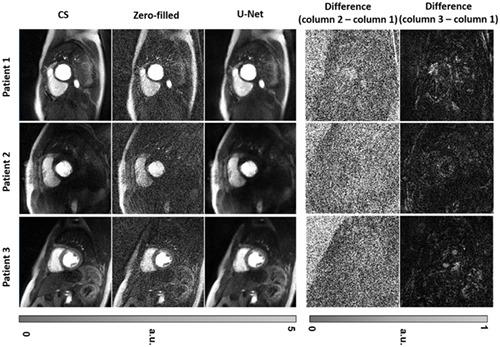当前位置:
X-MOL 学术
›
NMR Biomed.
›
论文详情
Our official English website, www.x-mol.net, welcomes your
feedback! (Note: you will need to create a separate account there.)
Rapid dealiasing of undersampled, non-Cartesian cardiac perfusion images using U-net.
NMR in Biomedicine ( IF 2.7 ) Pub Date : 2020-01-14 , DOI: 10.1002/nbm.4239 Lexiaozi Fan 1, 2 , Daming Shen 1, 2 , Hassan Haji-Valizadeh 1, 2 , Nivedita K Naresh 3 , James C Carr 1 , Benjamin H Freed 4 , Daniel C Lee 4 , Daniel Kim 1, 2
NMR in Biomedicine ( IF 2.7 ) Pub Date : 2020-01-14 , DOI: 10.1002/nbm.4239 Lexiaozi Fan 1, 2 , Daming Shen 1, 2 , Hassan Haji-Valizadeh 1, 2 , Nivedita K Naresh 3 , James C Carr 1 , Benjamin H Freed 4 , Daniel C Lee 4 , Daniel Kim 1, 2
Affiliation

|
Compressed sensing (CS) is a promising method for accelerating cardiac perfusion MRI to achieve clinically acceptable image quality with high spatial resolution (1.6 × 1.6 × 8 mm3 ) and extensive myocardial coverage (6-8 slices per heartbeat). A major disadvantage of CS is its relatively lengthy processing time (~8 min per slice with 64 frames using a graphics processing unit), thereby making it impractical for clinical translation. The purpose of this study was to implement and test whether an image reconstruction pipeline including a neural network is capable of reconstructing 6.4-fold accelerated, non-Cartesian (radial) cardiac perfusion k-space data at least 10 times faster than CS, without significant loss in image quality. We implemented a 3D (2D + time) U-Net and trained it with 132 2D + time datasets (coil combined, zero filled as input; CS reconstruction as reference) with 64 time frames from 28 patients (8448 2D images in total). For testing, we used 56 2D + time coil-combined, zero-filled datasets (3584 2D images in total) from 12 different patients as input to our trained U-Net, and compared the resulting images with CS reconstructed images using quantitative metrics of image quality and visual scores (conspicuity of wall enhancement, noise, artifacts; each score ranging from 1 (worst) to 5 (best), with 3 defined as clinically acceptable) evaluated by readers. Including pre- and post-processing steps, compared with CS, U-Net significantly reduced the reconstruction time by 14.4-fold (32.1 ± 1.4 s for U-Net versus 461.3 ± 16.9 s for CS, p < 0.001), while maintaining high data fidelity (structural similarity index = 0.914 ± 0.023, normalized root mean square error = 1.7 ± 0.3%, identical mean edge sharpness of 1.2 mm). The median visual summed score was not significantly different (p = 0.053) between CS (14; interquartile range (IQR) = 0.5) and U-Net (12; IQR = 0.5). This study shows that the proposed pipeline with a U-Net is capable of reconstructing 6.4-fold accelerated, non-Cartesian cardiac perfusion k-space data 14.4 times faster than CS, without significant loss in data fidelity or image quality.
中文翻译:

使用U-net快速去除欠采样的非笛卡尔心脏灌注图像。
压缩传感(CS)是一种有前途的方法,可用于加速心脏灌注MRI,以具有高空间分辨率(1.6×1.6×8 mm3)和广泛的心肌覆盖范围(每个心跳6-8片)来获得临床可接受的图像质量。CS的主要缺点是其处理时间相对较长(使用图形处理单元,每片带有64帧的切片约为8分钟),因此对于临床翻译不切实际。这项研究的目的是实施和测试包括神经网络的图像重建管道是否能够重建6.4倍加速的非笛卡尔(径向)心脏灌注k空间数据,其速度至少比CS快10倍,而不会显着降低图像质量下降。我们实施了一个3D(2D +时间)U-Net,并用132个2D +时间数据集(线圈组合,零填充作为输入;CS重建作为参考),来自28位患者的64个时间范围(总共8448个2D图像)。为了进行测试,我们使用了来自12位不同患者的56个2D +时间线圈组合,零填充数据集(总共3584张2D图像)作为我们训练有素的U-Net的输入,并使用定量指标将所得图像与CS重建图像进行了比较读者评估的图像质量和视觉评分(墙壁增强,噪音,伪影的显眼性;每个评分从1(最差)到5(最佳),其中3被定义为临床可接受)。与CS相比,包括预处理和后处理步骤,U-Net显着减少了14.4倍的重建时间(U-Net的重建时间为32.1±1.4 s,CS的重建时间为461.3±16.9 s,p <0.001),数据保真度(结构相似性指数= 0.914±0.023,归一化均方根误差= 1.7±0。3%,相同的平均边缘锐度为1.2毫米)。CS(14;四分位间距(IQR)= 0.5)和U-Net(12; IQR = 0.5)之间的视觉中位数总分无显着差异(p = 0.053)。这项研究表明,使用U-Net提出的管道能够以比CS快14.4倍的速度重建6.4倍加速的非笛卡尔心脏灌注k空间数据,而不会显着降低数据保真度或图像质量。
更新日期:2020-01-14
中文翻译:

使用U-net快速去除欠采样的非笛卡尔心脏灌注图像。
压缩传感(CS)是一种有前途的方法,可用于加速心脏灌注MRI,以具有高空间分辨率(1.6×1.6×8 mm3)和广泛的心肌覆盖范围(每个心跳6-8片)来获得临床可接受的图像质量。CS的主要缺点是其处理时间相对较长(使用图形处理单元,每片带有64帧的切片约为8分钟),因此对于临床翻译不切实际。这项研究的目的是实施和测试包括神经网络的图像重建管道是否能够重建6.4倍加速的非笛卡尔(径向)心脏灌注k空间数据,其速度至少比CS快10倍,而不会显着降低图像质量下降。我们实施了一个3D(2D +时间)U-Net,并用132个2D +时间数据集(线圈组合,零填充作为输入;CS重建作为参考),来自28位患者的64个时间范围(总共8448个2D图像)。为了进行测试,我们使用了来自12位不同患者的56个2D +时间线圈组合,零填充数据集(总共3584张2D图像)作为我们训练有素的U-Net的输入,并使用定量指标将所得图像与CS重建图像进行了比较读者评估的图像质量和视觉评分(墙壁增强,噪音,伪影的显眼性;每个评分从1(最差)到5(最佳),其中3被定义为临床可接受)。与CS相比,包括预处理和后处理步骤,U-Net显着减少了14.4倍的重建时间(U-Net的重建时间为32.1±1.4 s,CS的重建时间为461.3±16.9 s,p <0.001),数据保真度(结构相似性指数= 0.914±0.023,归一化均方根误差= 1.7±0。3%,相同的平均边缘锐度为1.2毫米)。CS(14;四分位间距(IQR)= 0.5)和U-Net(12; IQR = 0.5)之间的视觉中位数总分无显着差异(p = 0.053)。这项研究表明,使用U-Net提出的管道能够以比CS快14.4倍的速度重建6.4倍加速的非笛卡尔心脏灌注k空间数据,而不会显着降低数据保真度或图像质量。











































 京公网安备 11010802027423号
京公网安备 11010802027423号